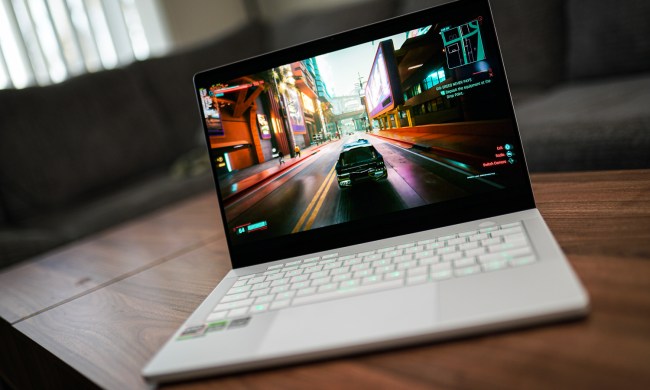
Nvidia has been busy with its next generation of GeForce hardware. In a quieter release, however, AMD launched the RX 590, a new graphics card that seems to play to the best of the company’s strengths. It’s a cost-effective alternative to Nvidia, priced at $280, right around the price of the GeForce GTX 1060.
We loaded the RX 590 into our standard test system, which consists of a Threadripper 1920x processor and 32GB of RAM, to see how AMD’s latest holds up.
Polaris, forevermore
The 590 is the latest in AMD’s Radeon RX 500-series lineup, which represents the company’s low end and mid-range gaming cards. Previous to the 590, though, they hadn’t been updated since April of 2017. Since then, the company has focused more on its RX Vega cards, which compete more directly with Nvidia’s upper-echelon of GPUs.
The RX 590 is a return to mid-range, where the majority of gamers find themselves in need of good options. It uses the same Polaris micro-architecture as the other RX 500-series cards, but is the first to use a more advanced 12-nanometer production node. That means these cards should provide better performance while consuming less power, which is good, because power draw has always been a main issue with AMD’s Polaris-based cards. Beyond that, there isn’t a lot new with the RX 590. It has a higher clock speed than the RX 580, but is otherwise similar.

In particular, AMD claims a twelve percent boost in performance, but according to our benchmarks, that didn’t quite hold true.
In 3DMark, we’re seeing a six percent increase in Fire Strike and a five percent increase in Time Spy. It’s an improvement for sure, but it’s not quite as substantial as was boasted. Both cards handily stomp the 1060 in both tests, and the RX 590 by a solid 15 percent. That feels substantial.
More significantly, the RX 590’s increase in speed pushes it ahead of the GTX 1070 in the DirectX 12-based, Time Spy benchmark. It won’t help in older games like World of Warcraft, but that’s good news for games that rely on that newer API.
We also ran the system through 3DMark’s VRMark tests to see how the card handled the heavy task of rendering 3D environments in virtual reality. Hitting a score of 7,781 in the Orange Room benchmark, it’s a considerable jump over the RX 580 and well beyond the 5,000 score required for minimum VR readiness with an Oculus Rift or HTC Vive.
A few frames for more than a few bucks
We also ran the RX 590 through our typical suite of test games to see how it lived up to the promise of a twelve percent increase in performance. Those tests include Battlefield 1, Civilization VI, and Deus Ex: Mankind Divided. We’ll start with gameplay with our screen resolution set to 1080p and graphics maxed out.
In Battlefield 1, the RX 590 earned an extra seven percent performance gain in both Medium and Ultra settings, over the 580. Achieving over a hundred FPS (frames per second), Battlefield 1 was responsive and beautiful. It was even enough to take advantage of our high-refresh gaming monitor.
Framerates for games like Civilization VI are trickier to judge because of how much the game taxes the processor. Regardless, the RX 590 pumps out a solid 75 FPS with settings on Ultra, more or less in pace with the 580. We couldn’t quite get over 60 FPS in Deus Ex, though it was a heck of a lot smoother than on a GTX 1060.
But what about if you want to play at a higher resolution? Well, the RX 590 can’t do much with 4K, but 1440p is doable at over 60 frames per second in most games.
In 1440p, the RX 590 earns some respectable framerates. Deus Ex was just barely playable on Ultra, but it squeezed out an average of 49 FPS on High. In both Deus Ex and Battlefield 1, the RX 590 held onto is fifteen percent lead over the GTX 1060. Again, we’re not seeing double-digit percentage advances over the RX 580 we hoped for.
For kicks, we threw on Fortnite in 1440p and enjoyed a buttery-smooth average of 120 FPS with the settings on High. At Epic, the action was still pretty close to 60 FPS.
These performance increases won’t be enough to move the needle for most people. But then again, the RX 590 was never meant as an upgrade from the current generation. AMD is hoping it can capture the interest of gamers on GTX 800 or 900 series cards looking for an upgrade.
Fortunately, the RX 590 helps fill in the gap between the 500-series cards and the Vega 56. For those that don’t want to spend a fortune graphics card, there’s now an option close to the GTX 1070 for Team Red. At $280, it’s more affordable than the GTX 1070. It’s really the only part of the price range AMD has some pull in, and the RX 590 completes the lineup well.
The problem? It’s fifty bucks more than the RX 580 and provides a fairly small performance difference in games. Beyond performance alone, the people that avoid AMD for problems of efficiency and power draw won’t find reason here to switch sides. Until we see AMD move away from Polaris and toward the anticipated 7-nanometer architecture, these mid-range cards will be more of the same. They are still a solid option for mid-range systems, but mostly, they have us interested in what AMD does next.







